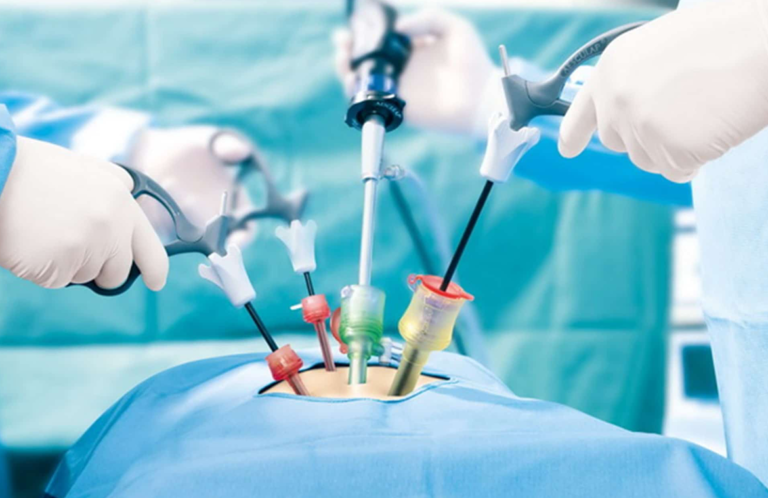Menu
16/1/3, The Landmark building, 3rd floor, Janjeerwala Square, near Sodani Diagnostic Center, Near Janjeerwala Square, Opposite B.B.C, Race Course Road, Indore, Madhya Pradesh 452001

Laparoscopic surgery – is a novel technique of performing abdominal operations using sophisticated camera systems and instruments.
The Basic Idea – Is to gain access into the abdomen without making a big cut as in conventional abdominal surgery.
The Technique Involves Insufflating – CO2 gas into the abdomen to create space and then making small 5-10 mm cuts through which the camera and instruments are placed.
The Camera System – Includes a long telescope which captures and transmits the image to the camera processor which in turn relays it to the monitor onto which the image is displayed .
The Instruments Have – Long shafts with fine tips to facilitate working from a distance. The surgery is performed by the surgeon and the assistants by viewing the image in real time on the monitor.
1. Conventional Laparoscopy – Using conventional laparoscopic trocars and instruments which are generally 5-10 mm in diameter.
2. Mini Laparoscopy – It involves using 3 mm trocars and instruments. This gives a better cosmetic outcome and is almost pain free in the post operative period. It is applicable for children , young women and in other special situations.
3. Single Incision Laparoscopic Surgery – This is a special technique in which all the trocars and instruments are placed through a single incision which is usually concealed within the navel/ belly button. Though it is technically difficult to perform, it gives the best cosmetic outcome and is often preferred when cosmesis is of primary importance.
1. Basic Laparoscopy – Gallbladder removal , Appendicectomy, inguinal hernia , ventral hernia and other hernia repair.
2. Advanced Laparoscopy – Hiatal hernia and GERD, Gastrectomy, Hepatectomy , CBD Exploration, Pancreatic surgery , Colorectal resections.
3. Laparoscopic Cancer Surgery – For cancers of digestive system, liver and pancreas.
4. Laparoscopic Gynecological Surgery – For ovaries, Fallopian tubes and uterus.
5. Laparoscopic Bariatric Surgery – For morbid obesity and uncontrolled diabetes.
6. Diagnostic Laparoscopy – For undiagnosed abdominal pain, cancer staging, biopsy and infertility.
7. Emergency Laparoscopy – For abdominal trauma, infections and peritonitis and drainage of pus within the abdomen.
8. Laparoscopy – may be used in special situations in surgery of breast, thyroid and adrenal. Also the principles of laparoscopy are used in arthroscopy for joint surgery and in urology for surgery of bladder, prostate and kidney.
1. The Risks For Laparoscopic Surgery Are The Same As For Conventional Surgery –Some of the procedure related risks such as bleeding, infection, pain, wound complications and hernia are much lesser as compared to conventional open surgery.
2. This Is Because The Procedure – Is minimally invasive and the cuts are extremely small. Sophisticated instruments such as are used for dissection which make the procedure almost bloodless.
3. Some Of The Potential – Risks due to the insufflation of CO2 gas such as Hypotension, hypercarbia and embolism make the procedure unsuitable in patients with shock, severe cardiac and respiratory diseases, and very old patients. For such situations, conventional open surgery may be preferred.
1. It Is Laparoscopic Surgery Which Is Aided By a Robotic Telemanipulation System – Controlled by the operating surgeon. The surgeon sits at the console and controls the robotic arms which are attached to the operating table at the patients side.
2. It Has The Additional Advantage – Of 3D visualization, fine scaling of movements and reducing hand tremor and simultaneously improving the dexterity of the surgeon by increasing the range of movements of the instruments.
3. Though It Improves The Comfort Level – For the operating surgeon, it offers no additional benefit to the patient over conventional laparoscopic surgery though it comes at a much higher cost. Thus , it’s use has been limited to certain urological surgeries and special situations in which much difficulty is anticipated with conventional laparoscopy.
16/1/3, The Landmark building, 3rd floor, Janjeerwala Square, near Sodani Diagnostic Center, Near Janjeerwala Square, Opposite B.B.C, Race Course Road, Indore, Madhya Pradesh 452001
© 2025 Dr. ACHAL AGRAWAL | All Rights Reserved | Powered by Mrdigito.com